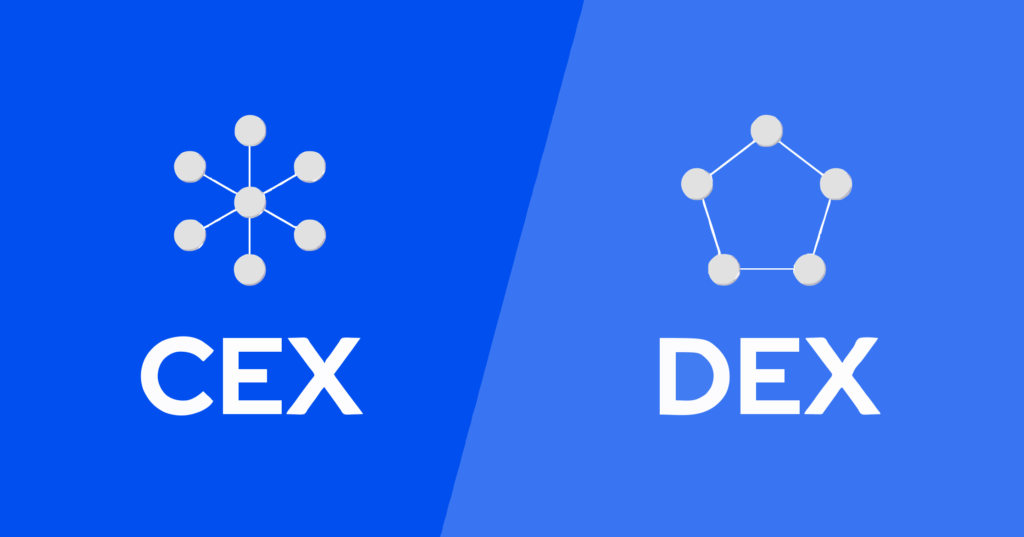Centralised vs. Decentralised Exchanges: A Comprehensive Comparison

This guide provides an overview of centralised (CEX) and decentralised (DEX) exchanges, highlighting their advantages, drawbacks, and key differences. We’ll also explore where the industry is heading and what traders should consider when choosing between the two.
What Is a Centralised Crypto Exchange (CEX)?
A centralised exchange (CEX) is a platform where users can trade cryptocurrencies, acting as an intermediary between buyers and sellers. These exchanges are called “centralised” because they are managed by a central authority, providing structured and regulated trading environments.
How Trading Works on a CEX
Before trading on a CEX, users must register and verify their accounts. Traders can deposit cryptocurrencies or use fiat on-ramps to buy crypto via credit cards, bank transfers, or other payment methods.
Trading on CEXs happens through order books, where traders can place limit orders, stop orders, and other trade types. To ensure efficiency, centralised exchanges implement high-speed matching engines that execute trades in milliseconds, providing seamless user experiences and reducing price swings during market volatility.
Advantages of Centralised Exchanges
🔹 Fiat Integration – Users can buy cryptocurrencies with fiat currencies and withdraw funds back to traditional bank accounts. 🔹 High Liquidity – Market makers and institutional traders provide high liquidity, ensuring smooth and efficient trades. 🔹 Broad Asset Selection – CEXs support various cryptocurrencies, allowing seamless cross-currency trading. 🔹 User-Friendly Experience – Intuitive interfaces and customer support make CEXs accessible for both new and experienced traders.
Disadvantages of Centralised Exchanges
⚠️ Custody Risk – Users must trust the exchange with their funds, relinquishing control of their assets. ⚠️ Single Point of Failure – CEXs are prime targets for hacks. For example, Crypto.com lost $35 million in a breach earlier this year. ⚠️ Lack of Transparency – Transactions are not fully visible on-chain, and withdrawal processes may lack real-time tracking.
For those who prioritize self-custody and decentralization, decentralised exchanges (DEXs) offer an alternative.
What Is a Decentralised Exchange (DEX)?
A decentralised exchange (DEX) operates as a smart contract on a public blockchain, eliminating the need for intermediaries. Unlike CEXs, DEXs allow users to trade directly from their wallets, maintaining full control over their assets.
Early DEXs relied on on-chain and off-chain order books, but these were inefficient due to low liquidity and slow transaction speeds. The rise of Automated Market Makers (AMMs), introduced by Uniswap, revolutionized decentralised trading.
Automated Market Makers (AMMs) & Liquidity Pools
AMMs set asset prices using mathematical formulas, removing the need for order books. Instead of trading peer-to-peer, users trade peer-to-pool.
💰 Liquidity Providers (LPs) deposit tokens into liquidity pools, earning transaction fees and sometimes governance token rewards. 💰 The more liquidity in a pool, the smoother the trading experience. 💰 Impermanent Loss occurs when deposited assets deviate in value from their market price, impacting LPs’ returns.
Advantages of Decentralised Exchanges
✅ Non-Custodial – Users retain full control over their assets, aligning with crypto’s core principles of self-sovereignty. ✅ Permissionless Access – Anyone with an internet connection can trade on a DEX, regardless of location. ✅ Transparency – Every transaction is recorded on-chain, providing full visibility into trading activity. ✅ Censorship Resistance – No central authority can restrict or censor trades.
Disadvantages of Decentralised Exchanges
⚠️ Impermanent Loss – Liquidity providers may face losses when asset prices fluctuate. ⚠️ User Experience – DEX interfaces can be complex for beginners, requiring technical knowledge to navigate. ⚠️ Limited Token Support – DEXs primarily support tokens native to their blockchain (e.g., Ethereum-based DEXs support ERC-20 tokens but may not easily support Bitcoin). ⚠️ Security Risks – Vulnerabilities in smart contract code can be exploited by hackers.
Key Differences Between CEX and DEX
| Feature | Centralised Exchange (CEX) | Decentralised Exchange (DEX) |
| Custody | Exchange holds funds | Users control funds |
| Security Risks | Prone to hacks & breaches | Smart contract vulnerabilities |
| Liquidity | High, supported by market makers | Lower, depends on liquidity pools |
| Transaction Speed | Fast (off-chain execution) | Slower (on-chain execution) |
| Regulation | Subject to KYC/AML laws | Permissionless access |
| Transparency | Limited visibility | Fully visible on-chain |
| User Experience | Beginner-friendly UI, support available | Requires blockchain knowledge |
Where Is the Industry Heading?
The future of cryptocurrency trading will likely see coexistence between CEXs and DEXs:
🚀 Hybrid Exchanges – Platforms that merge CEX liquidity with DEX self-custody are gaining traction. 🚀 Cross-Chain Solutions – Bridging assets between different blockchains will improve DEX token support. 🚀 Institutional Involvement – CEXs remain dominant due to compliance requirements, but institutions are exploring DeFi. 🚀 Security Enhancements – As blockchain technology matures, smart contract security will continue to improve.
Final Thoughts: Choosing Between CEX and DEX
Both centralised and decentralised exchanges play critical roles in the cryptocurrency ecosystem. The choice between the two depends on a trader’s priorities:
🔹 Use a CEX if: You prefer convenience, fiat support, and institutional-grade liquidity. 🔹 Use a DEX if: You value decentralization, privacy, and self-custody over ease of use.
At BCB Group, we work with businesses across the blockchain and fintech sectors, supporting both centralised and decentralised platforms. Our solutions provide seamless payment rails and multi-currency transaction processing for leading exchanges.
📩 Reach out to our team to learn how we enable exchanges to thrive in the evolving crypto landscape.